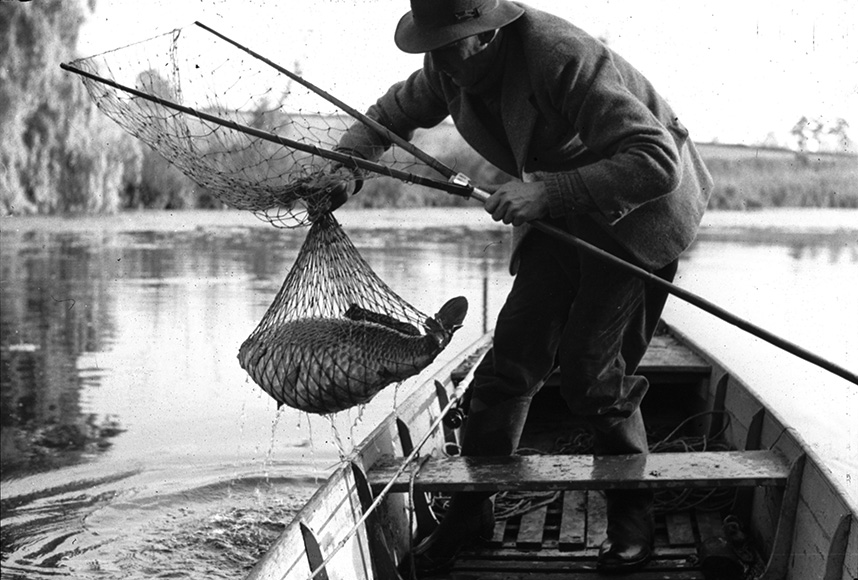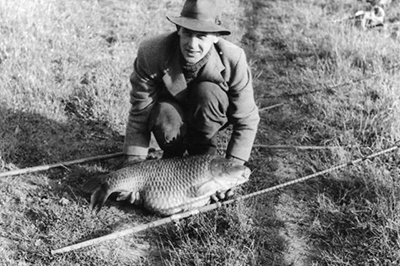| Dick Walker Does It Again | ||
In June 1954, Dick caught another common carp weighing 34 lb. The capture is recounted in the carp chapter of No Need To Lie "We now know that this fish actually weighed 34 lb. Dick, already holding the carp record, having taken it away from Bob Richards, didn't want to eclipse him again. So when Bob, who was opposite Dick and Pete as they weighed the fish, said somewhat despondently "You've beaten me again Dick", Dick lied and told Bob that he hadn't and the fish was identical in weight to Bob's. The fact remains however, that Dick was now the only man in angling history to have caught the two largest fish of a particular species, a feat unrivalled before or since." Whether the last line is still true, is being investigated.
"One of the reasons why we look forward to the first weekend of a new season is that it will be the first chance to try new theories and ideas that we have thought up when we couldn’t try them out. Very often we find that they don’t work out as well in practice as we had hoped, but sometimes they answer surprisingly well. As far as the first weekend of the 1954 season was concerned, they worked out very nicely for me. Before I tell you what happened, I’d better explain what some of these ideas and theories were. First of all there was the question of losing big fish at Redmire, not because they broke the tackle but because, somehow, they got rid of the hook. Maurice Ingham and Bob Richards have both hooked monster fish, only to have the hook-hold give after playing them for a time. I had lost no fewer than four whoppers in the same way during the previous two seasons. Pete Thomas suggested that this was due to the peculiar shape of the mouths of the big Redmire fish. Their mouths are very much “underslung”, and Pete pointed out that a hook struck upwards could scarcely help coming up against bone, into which it would penetrate only a little way, and come out again very easily. So we decided it would be a good idea to use a running lead, stopped a few inches from the hook. The pull on striking would then be downwards and the hook would penetrate the bottom lip. This had happened to the 22¾ lb. and 17½ lb. carp I caught at Dagenham in 1952, using sunk crust and an Arlesey bomb. Secondly, there was the idea that fish can become preoccupied not only with foods of certain kinds, but with particular sizes. I hope to explain this more fully some other time, but it led us to think that lumps of groundbait ought to be about the same size as the hookbait. Thirdly, there was an idea for circumventing the craftiness of a big carp that was in the habit of feeding along a sort of shelf at the dam at Redmire. This dam is about a 100 yards long, squarely across the end of the lake, and about 5 yards out from its middle is the deepest part of the lake, about 12 feet. But close to the dam itself is this shelf, about 4 feet wide and 5 feet below the surface. There are dense weed-beds along the sides of the lake, and I’d found that a big carp would come out of the weed-bed at the east end of the dam and feed on groundbait along the shelf. I hooked and lost him in June, 1952, and from then on, groundbait along that shelf was never eaten by next morning if I or anyone else sat anywhere along that dam, no matter how quietly we sat behind bushes. But if we went off and fished somewhere else, morning found groundbait along the shelf all gone. So here was a problem to solve. |
||
|
Pete and I arrived at Redmire at about 10 p.m. on June 19th. The weeds along each side of the lake were very, very thick, and packed together with algae and scum. The only open water was a strip down the centre of the lake, 40 to 50 yards wide and ending at the dam. We groundbaited along the shelf at the dam and fished till about 4.30 a.m., then we gave it up, removed our baits and went to sleep. The groundbait was untouched then, but when we looked again at about 7 a.m., it was all gone. The next evening I chose a position on the west bank about 40 yards from the dam, and cast diagonally to the right, so that my lead fell on the dam itself, about 50 or 60 yards away. The tackle consisted of a James number 3 carp hook, carefully sharpened, tied to the end of 200 yards of 9 lb. breaking strain perlon monofil, dyed deep chestnut in silver nitrate solution. A 1 oz. Arlesey bomb was stopped by a small shot about 6 inches from the hook. Rod and reel were the usual MK IV and Mitchell. I walked round to the dam, found the tackle, baited with a piece of new flake the size of a pheasant’s egg, squeezed it so it would sink and dropped it in so that it sank to the shelf. Then I scattered about twenty similar pieces around it. Returning to the rod, I put it in its bite-alarm rests and wound in the slack. But my line was now lying across a dense weed-bed, through which it seemed impossible to drag a big fish. I could not get back to the dam after hooking a fish, because trees and brambles made this impossible. So we fetched the boat over and moored it in a little bay a few yards to the left of my rod.
|
|
|
||
Bob Richards, holder of the king carp record, with a 31 lb. 4 oz. fish, had joined us that evening, and he, Pete and I sat talking till after midnight. Then Bob went off to fish a gap in the weeds on the east side, while Pete cast out over the weeds to my left. Our long vigil had begun. It continued until daybreak, and after. The sun rose deep orange, its beams making the lake steam. Nothing moved; I was lost in a quiet world of green and grey and gold. Then, at 5 a.m., the bite alarm, which I had not troubled to switch off, sounded, and the line slithered and snaked away through the rings. Sixty yards away, under the mist and the still green water, something had picked up the bait and was making off with it, fast. I cannot tell you how I picked up the rod, dropped in the pick-up of the reel, and struck, because I don’t remember. But I must have done it right, for there I was with the rod arched and the slipping clutch snarling as something big and powerful shot up the lake and then turned into the weeds, still going fast, on the far side. It went into those weeds and kept going, but when it stopped at last it remained stopped. Nothing I could do, not even fierce hand-lining, shifted it an inch. Pete unhitched the boat and paddled it past the jutting piece of grass bank on which I stood. I jumped in, and across to the other side we went, following the line. Up it came, with festoons of weed and green slime which slid down it back into the water. Presently it ran straight up and down. I bent the rod more and more, and something down below began to rise. Then it began to move, very slowly, up the lake. I kept the pressure on, and up to the top came the fish, beating the water in rage and flinging the festooning weeds off the line. Then he rolled over and went down, away and out into the open water. Pete paddled the boat after him for dear life. |
||
 Dick Walker hauls his catch on board. |
||
|
Once in the clear, we made sure he stayed there, and eventually, after a slogging struggle, he came up, rolled, and plunged down again; but this time it was into the bottom of the great net. I dropped the rod and heaved him into the boat, and there was the hook, right through the bottom lip. Bob Richards was waiting for us, all smiles, when we reached the bank, and he had the spring balance ready. The weight was 31 lb. 4oz., the same as his own big fish, and the length 31 inches. After we had taken some photographs, I slid the fish back to grow into a fifty-pounder, which I hope Bob will one day catch". - Richard Walker |
|
Points of interest: |
||
 Dick Walker with his fish. |
The rod being used by Dick is one of his own making - the MK IV carp rod, designed and built specifically for the capture of big carp, as there was nothing on the market suitable. The landing net was also made by Dick, with 36" arms and sufficient net depth to engulf the sizeable fish they sought. In the picture with the caption 'At 5 a.m. the bite alarm sounded...'' we can also see another Walker innovation in the shape of an electronic antennae bite alarm, codenamed 'Bedlam' invented the year before. |
|
| Copyright dickwalker.co.uk 2015 | ||